A Beginner’s Guide To Photographing Comet NEOWISE
![]()
The comet C/2020 F3 (NEOWISE) has arrived in the night sky here in the northern hemisphere, delighting skywatchers and photographers alike. With planning, patience, and clear skies, you can capture an unforgettable image of this celestial event.
I hope this article will answer those questions for anyone else who hopes to capture this rare astronomical treat.
“Stonehenge, England” above was shot with a Nikon D850 and Tamron 70-200mm f/2.8 at 102mm – f/2.8 – 2 sec – ISO 1250. 6 x frames stacked using Starry Landscape Stacker; slight crop
Where and When
NEOWISE appears in the N-NW evening sky. The ambient light in the sky after sunset can make it challenging to find at first, so here’s a tip for locating the comet with the naked eye: try defocusing your eyes and scanning the sky quickly, it helps you see the faint glow of the tail.
If it’s still too faint to see with the naked eye, you can try hunting for it using a fast lens. I took a wide-angle shot looking north using my Sigma 14mm f/1.8 and quickly located the comet’s tail 10-15 minutes before I found it easily visible using just my eyes.
Nobody knows for sure how long NEOWISE will be visible at night. In theory, the comet should be visible in the northwest evening sky later in July, but this is not guaranteed so shoot it while you can!
Equipment
As essential as the camera itself is a tripod sturdy enough to take the weight of your gear and hold it still for up to 30 seconds (depending on how wide you shoot). A lightweight or travel tripod is a good idea if you’re hiking to a spot, but it may not perform so well over long periods or if there’s a wind.
Shoot with a fast, prime lens if you can – this will work best as a wide aperture allows you to capture more light and a more detailed image.
The tail of the comet covers a larger area than it appears to the naked eye – you could be forgiven for believing you’d need a zoom lens. Actually, you can achieve pleasing results with wider angles too.
If you don’t have one already, a nifty fifty (a 50mm prime lens) tends to be an inexpensive option that provides a pleasing focal length to capture the comet with exposure times of up to 10 seconds.
Finally, consider a remote shutter, either wired or wireless cable. You can pick one of these up cheaply on eBay rather than use your camera manufacturer’s branded model. When you press your camera’s shutter release you introduce a little bit of motion which can interfere with your images. A remote shutter eliminates this. Alternatively, check if your camera has a built-in timer. For example, on my Nikon D850, I can safely shoot using the camera shutter release when I set my timer to 5 seconds.
Here’s an idea of how the comet will look at various focal lengths.
35mm
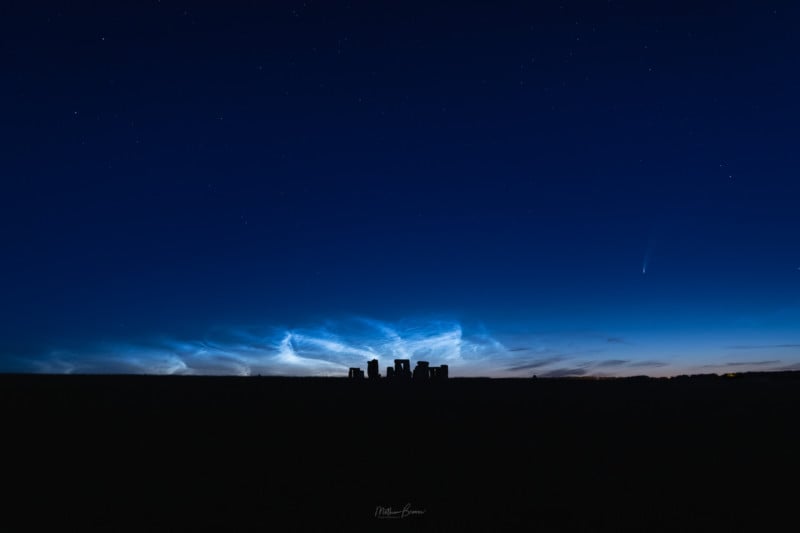
On a full-frame camera, you should be able to shoot for up to 14 seconds without any star trailing.
50mm
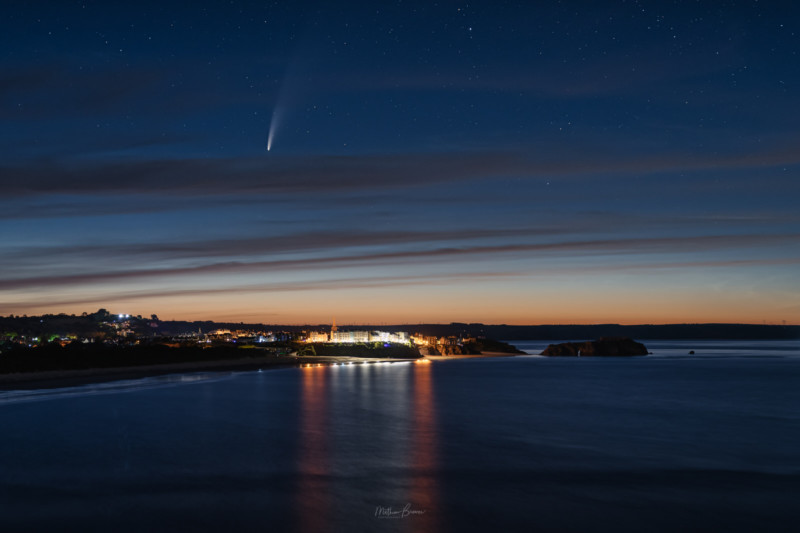
On a full-frame camera, you should be able to shoot for 10 seconds without any star trailing.
200mm
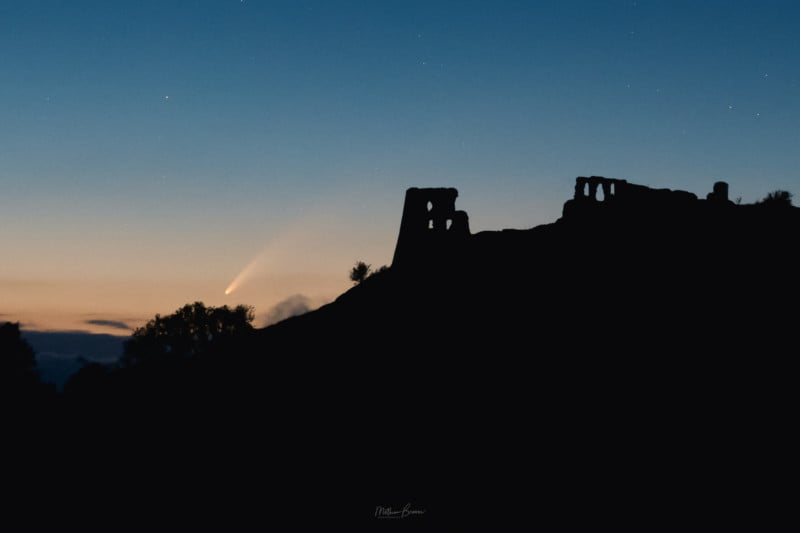
On a full-frame camera, you will only be able to shoot for 2 seconds before star trailing happens. This means you’d need a wide aperture and a high ISO for a well-exposed shot
Recommended Apps and Websites
Stellarium
![]()
Stellarium is a free, open-source planetarium for your computer, there’s also a web version. You can input your location and Stellarium can show you how the sky will look at any time. Click on NEOWISE and Stellarium will show you the azimuth (direction) and altitude for any given time.
Clear Outside
![]()
Clear Outside is a weather app for astronomers which gives a detailed breakdown of cloud cover. It’s free to use online or as an iOS and Android app. Ideally, you want totally clear skies, but remember the comet can still be seen through breaks in clouds — particularly wispy, high-level clouds.
The Photographer’s Ephemeris
![]()
The Photographer’s Ephemeris is an extraordinary planning tool available as a paid iOS and Android app, and free to use on the web – registration is required. Using this tool you can plot your viewing location, an object you want to shoot, and TPE will tell you the direction and altitude. Combine this with Stellarium to work out where NEOWISE is in the sky, and how this will work with the object you want to shoot.
PhotoHound
![]()
Finally, PhotoHound is a handy tool for finding notable photo locations around the world – and I’m not just saying this because I happen to be one of its co-founders! The web version is free to use – registration is required. Look for places of interest and see if these can be combined with NEOWISE to create a compelling image. (And when you do, you’re welcome to add it to the PhotoHound map.)
Composition Ideas
Now you’ve located NEOWISE in the sky you need to decide how to shoot it. You could isolate the comet against the night sky, or look for an interesting foreground interest. Here are some ideas for you to try out.
Capture the comet and the landscape
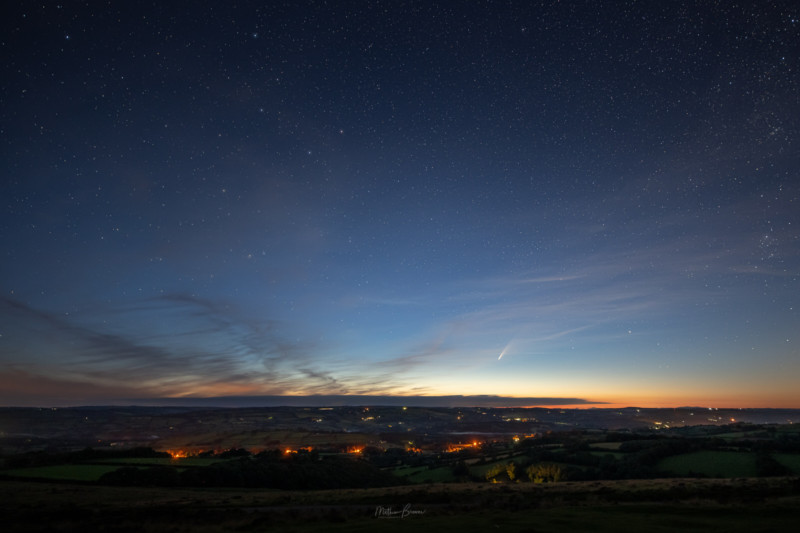
This is the easiest way to shoot it, with a wider lens and illustrating a beautiful starlit landscape.
Consider photographing from higher ground to give you a pleasing perspective of the skies above and the land below in a single frame. This also gives you the advantage of avoiding low-level fog and mist that can form on lower ground overnight.
Photograph the comet with an object or landmark
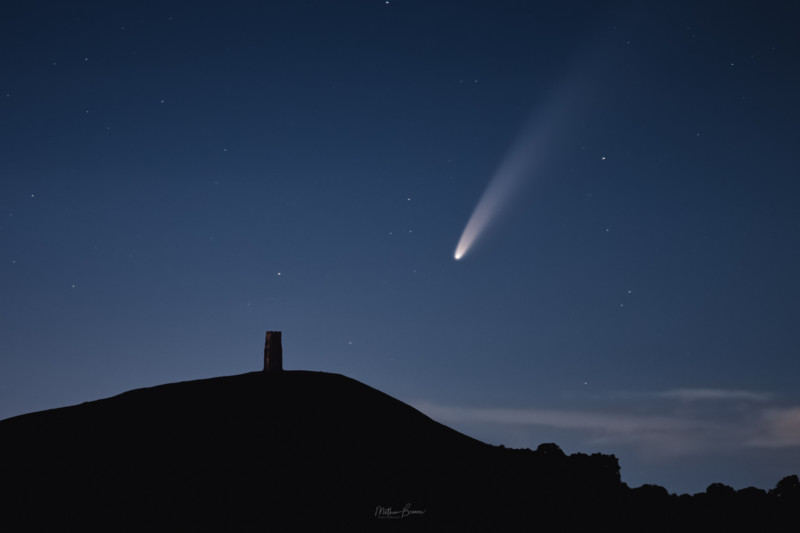
Find a notable landmark, building, or other object and photograph it next to the comet! You’ll need a combination of the apps above to find a suitable angle and time, but when these work in your favor you’ll produce a crowd-pleasing image for sure!
Isolate the comet
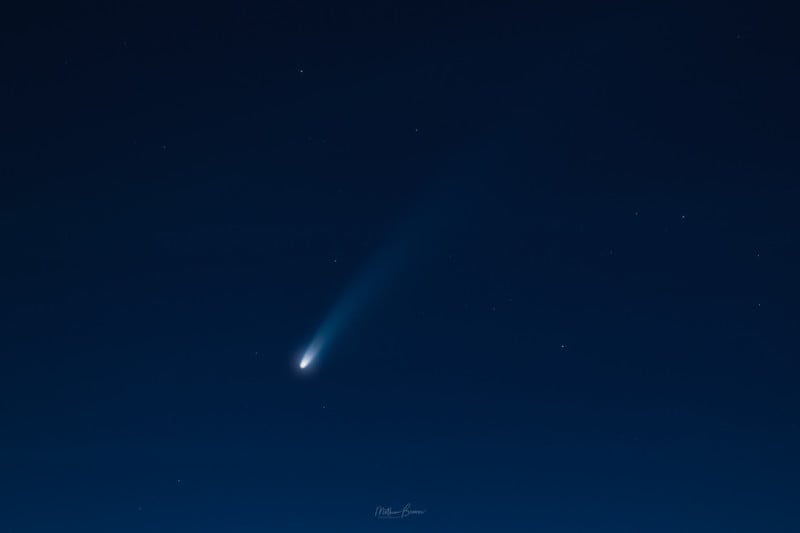
This is the trickiest to achieve as you’ll need a good zoom, and the longer your focal length, the shorter your exposure must be to avoid star trailing.
If you want to create longer exposures than this, you’ll need to use a star tracker. This is quite an advanced technique, well beyond the realm of this beginner’s guide! An easier alternative is to capture multiple short exposures at a high ISO, and stack these frames using software like Sequator or Starry Landscape Stacker to reduce noise.
The 500 Rule
If you’re not sure how long to expose for, you need to check something called the 500 Rule which is used to calculate the longest exposure time you can achieve before the stars become blurry.
The formula is as follows:
500 ÷ (Crop factor x Focal length) = Shutter speed
That can be a bit difficult to get your head around when you’re shooting the stars at 2 in the morning, so here’s a table featuring common focal lengths.
![]()
I hope this article helps you capture this incredible display in the coming days, capturing a memento of this historic occasion for years to come. Astrophotography takes patience and technical skill, but the results are worth the effort. I love seeing photos of NEOWISE as well as capturing it for myself – you’re welcome to tag me on social media to come and see your work.
About the author: Mathew Browne is a photographer from south Wales and the co-founder of PhotoHound, an online community for photographers to share information on the world’s best photo locations. The opinions expressed in this article are solely those of the author. You can find more of Browne’s work on his website, Facebook, Instagram, Flickr, and 500px. This article was also published here.